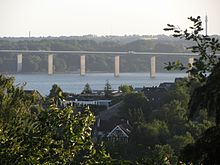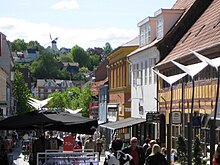Vejle is a city of 61,000 people (2023) in eastern South Jutland, part of the Kolding–Vejle–Fredericia triangle. Vejle is most known for its forested hills, fjord, harbour, shopping, pedestrian mall, and windmill.
Understand
editDevelopment of new architecture, art and alternative town spaces throughout the 1990s has made the city an attraction. Vejle was the first city in Denmark, which had its own official architecture policy to set high standards for the urban development.
Vejle is the regional capital of South Jutland, one of the 5 Danish regions.
History
editThe first recorded mention of the town is from 1256, and the first known merchant town privileges were issued by King Valdemar III in 1327. During the Middle Ages, Vejle was important as a market town, and developed along those lines up to the mid-17th century, trading with cities such as Lübeck and Flensburg, in what is now Germany.
In the late 17th and early 18th centuries, Vejle's population was diminished as a consequence of plague and war. The town expanded throughout the 19th century, benefiting from improvements such as a new harbour on the fjord, a railway station, and modern utilities. From the mid-19th century into the 20th century, Vejle developed from a provincial market town into a busy industrial centre, eventually becoming known as the "Manchester of Denmark" for its many cotton mills.
Get in
editBy train
edit
Vejle is on the main Copenhagen–Aarhus–Ålborg train line with several departures every hour. It is a stop for all trains passing through, including InterCityLyn (ICL) from Copenhagen Airport, and ICE (InterCity Europe) trains from Hamburg and Berlin.
By car
editBy air
edit- 2 Billund Airport (BLL IATA). located about 30 km from Vejle, with several bus departures every day.
Get around
edit- 3 Vejle Transit Centre (Vejle Trafikcenter), Banegårdspladsen 3B. Vejle station provides nine city bus lines to various neighbourhoods, as well as national and international coach and train services.
- Vejle Taxa, ☏ +45 70201222.
See
edit- 1 St. Nicolai Church (Sankt Nicolai Kirke), Kirketorvet 1. Old church. See the exhibited Haraldskær Woman, a well-preserved Iron Age Nordic mummy.
- 2 Vejle Rådhus. The city hall of Vejle. No public access unfortunately.
- 3 Den Smidtske Gård, Søndergade 14. Old courtyard in a restored timber-framed merchants house from 1799. Cafe Conrad and a branch of Vejle Museum is located here. This is one of the only medieval buildings in Vejle, before the rapid industrialisation of the late 1800s.
- 4 Vejle Windmill (Vejle Vindmølle), Søndermarksvej 1. Summer: Tu-Su 11:00-16:00. This 20-m-high windmill was built in 1890 and is a landmark of the city. Free.
- 5 Vejle Museum of Art (Vejle Kunstmuseum), Flegborg 16-18. Tu-Su 11:00-16:00. It has Danish paintings and sculptures from classic modernism to medical Dürer and abstract expressionism on display. The museum is also home to a collection of Golden Age paintings from the Vejle area as well as a collection of drawings, e.g. 50 etchings by Rembrandt. Free.
- 6 Culture Museum in Vejle (Kulturmuseet Spinderihallerne), Spinderigade 11, ☏ +45 76 81 31 00. Tu-Su 11:00-16:00. Engage in the history of Vejle. Include exhibitions on one of the world's best-preserved bogs, hiw industrialization created the world we know today, and the history of nightlife. All the museum's exhibitions have fun activities for children. Free.
- 7 Givskud Zoo. zoo with a wide range of animals; worth mentioning is lions, rhinos, gorillas, giraffes, elephant and wolves.
- 8 Tørskind Gravel Pit. Sculpture park by Robert Jacobsen
- Vejle City Hall
- Bølgen (The Wave). A modern iconic residential building at the harbour front.
- Den Hvide Facet. Vejle has several iconic modern buildings.
- Bryggen, shopping centre and recreational harbour front.
- Musikteatret, a cultural center for music and theatre.
- The stream of Vejle Å cuts through the city.
- Lido Biograferne.
- Økolariet, a regional center for organic production.
- Den Smidtske Gård.
- St Nicholas' Church
- Haraldskær Woman on display in a glass-covered sarcophagus.
Do
edit- 1 Albuen Strand (the elbow). Artificial beach at the northern side of the fjord
- Football: Vejle Boldklub were promoted in 2023 and now play soccer in Superliga, the top tier. Their home ground Vejle Stadium (capacity 11,000) is 1 km northeast of city centre.

- Danmark Rundt. The annual Danish UCI cycle race, often has its final stage in Vejle. The finishing line is at the end of Kiddesvej (steep by Danish standards) in city centre.
- Trekantsområdets Festuge. A ten-day regional culture festival every year in late August.
The countryside around Vejle offers some beautiful nature sights, and it is also a starting point of the long-distance hike of "Kyst til Kyst Stien".
- Kyst til Kyst Stien. Walk coast to coast, from Vejle to Blåvand, across the base of the Jutland peninsula in a varied landscape, including river valleys, meadows, heathland, and historic sites. Top quality trail of more than 130 km all together, equipped with shelter and camping sites, running water and toilets. Fit for families, with easy access to shopping opportunities along the route.
Buy
edit
- Strøget. A long street in the pedestrianised centre lined with historic buildings, cafés, restaurants and specialty boutiques, ideal for shopping. Most larger Danish cities have a "strøget" street.
- 1 Bryggen.
Vejle is known regionally as a vibrant shopping town with a wide and varied offering of chain and specialty shops along the city's central pedestrian street. The shopping centre, Bryggen, has 38 stores and two restaurants and lies within the pedestrian street.
Street food can also be experience at the Paladspassagen Social Dining at the former Mary's Shopping Centre.
Eat
edit- Brōed & Bōef, Nørregade 61, ☏ +45 92909027, info@broedboef.dk. A burger bar in the umbrella street.
- Conrad Cafe, Søndergade 14, ☏ +45 75720122, martin@conradcafe.dk. A cafe in Den smidske gaard.
- [dead link] Caféen - Den Gamle Arrest, Klostergade 1, ☏ +45 75829300. A cafe in the old prison.
- MeMu.
- Remouladen.
- Sinatur Hotel Harldskær.
- Trattoria Dei Re.
- Tree Top.
Drink
edit- [dead link] Vejle Bryghus, Dæmningen 42 G, ☏ +45 70 20 99 64. Vejle's largest brewery.
Sleep
edit
- Vejle Vandrehjem (Vejle Youth & Family Hostel), Vardevej 485 (6 km outside Vejle center; bus No. 2 goes there 1-2 times an hour), ☏ +45 75825188, fax: +45 75831783, info@vejle-danhostel.dk. Check-out: 22:00. bring IH card. You can rent linen for kr 50 or bring your own. depends on number of people in a room, kr 200 in a shared room.
- 1 Vejle Fjord, Sanatorievej 26, Stouby, ☏ +45 76823380, receptionen@vejlefjord.dk. Hotel, conference center, spa, and restaurant outside Vejle at the fjord.
- 2 Haraldskær, Skibetvej 140, ☏ +45 76496000, har@sinatur.dk. Hotel and restaurant outside Vejle close to nature which gives a relaxing experience.
- 3 Scandic Jacob Gade, Flegborg 8, ☏ +45 76 70 00 00, jacobgade@scandichotels.com. New-built mid-range hotel attached to the Vejle Music Theatre, next to the City Park. Rooms are efficiently designed, and large for Scandinavia. 700 m from the railway station.
- 4 Best Western Torvehallerne, Fiskergade 2-8, ☏ +45 79427900, info@torvehallerne.dk. Check-in: 14:00, check-out: 12:00. Best Western Torveallerne is located in the heart of Vejle only 2 minutes walk from the train station.
Go next
edit- Jelling, a UNESCO World Heritage Site. The old Danish capital with the Jelling stones and burial mound is ca 15 minutes north on the Struer train line, kr 16.
- Jernalderlandsbyen (The Iron Age Village), a large reconstructed Iron Age village with engaging activities for the whole family.
| Routes through Vejle |
| Aalborg ← Horsens ← | N |
→ Kolding → Hamburg |












